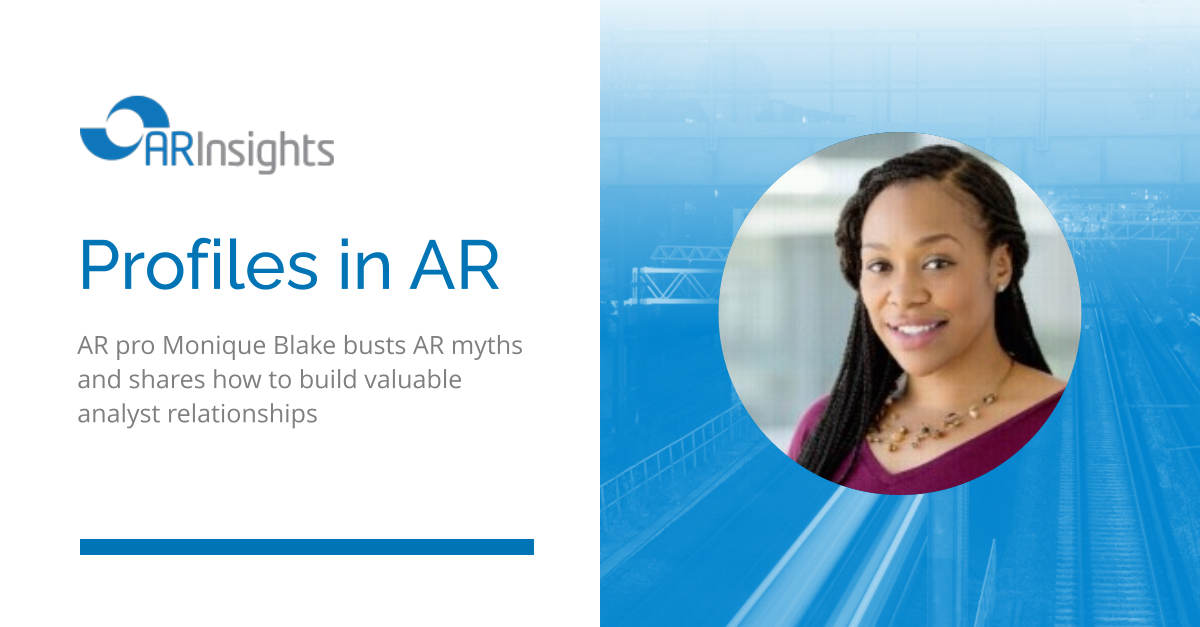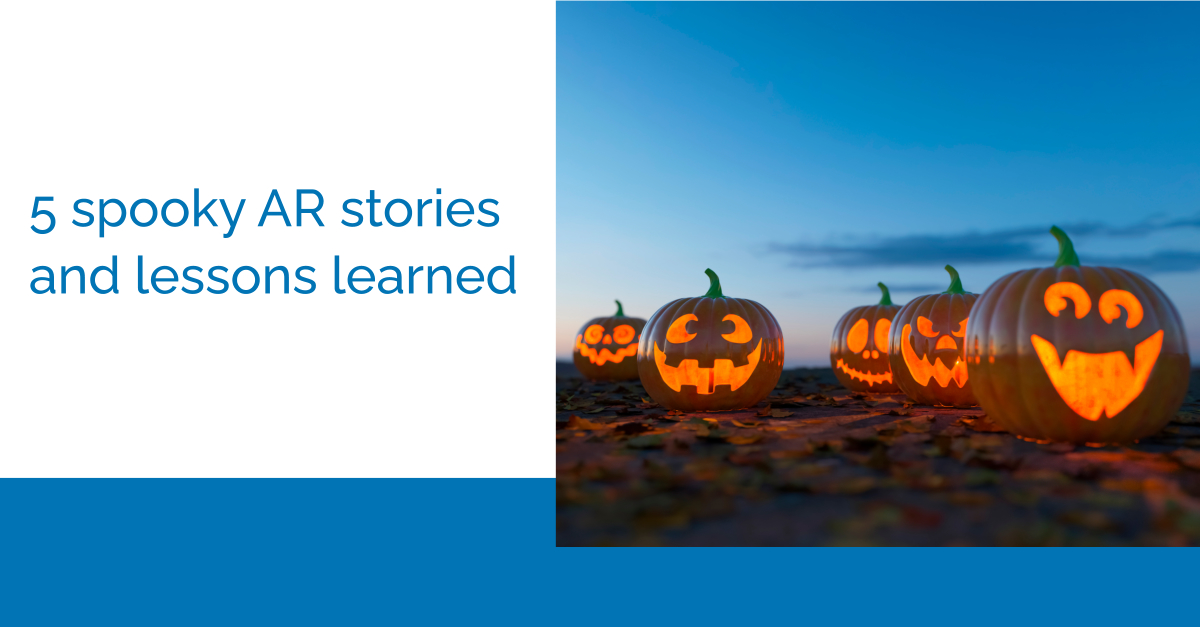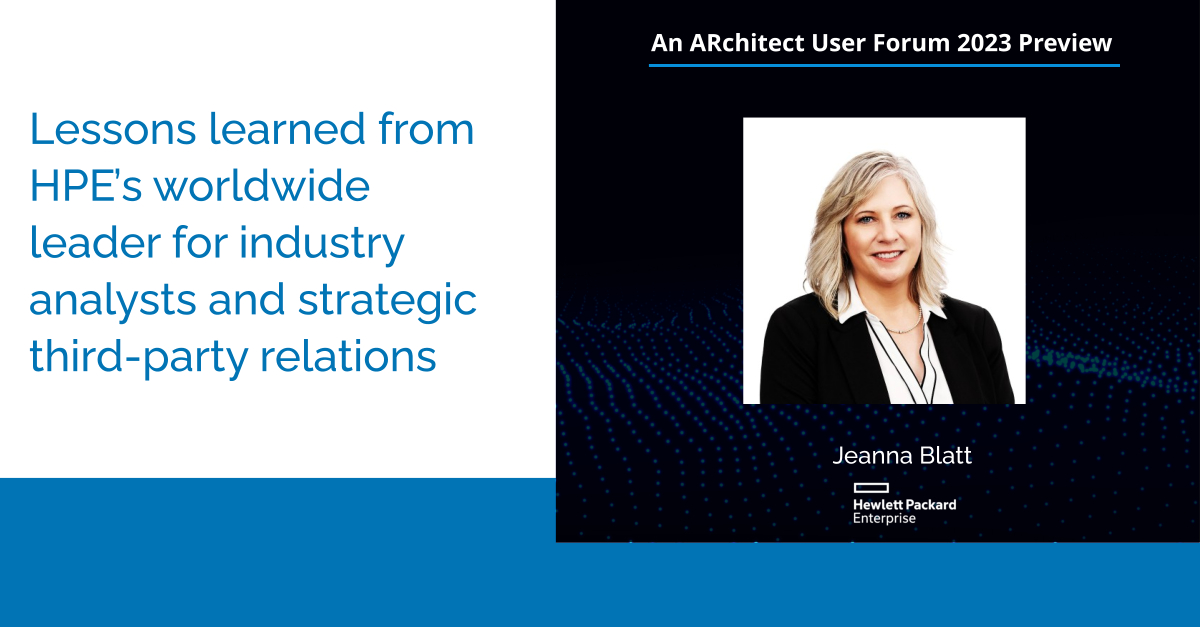Looking for illuminating AR advice and information? You’re in luck. Our next “Profile in AR” is a great one!
We were thrilled to connect recently with Monique Blake, VP of analyst relations at consulting firm Synaxis. An experienced AR professional, Monique previously managed analyst relations at Oracle, Neustar, Appian and MarkLogic. In her interview below, Monique compares AR at a consulting firm with AR in-house, discusses how Synaxis works with clients, and shares valuable and actionable AR strategies. We think you’ll get a lot out of this Q&A!
Q: Thanks for spending time with us, Monique! First, what’s your best advice on building analyst relationships?
Monique: It’s always a priority to help my clients get positioned accurately and positively in research. My second biggest priority, though, is making sure that analysts also get what they need out of the relationship.
Keep in mind: Relationships are a give-and-take. So the approach, as a vendor, should be going into a meeting and saying, “What do you need from us?” Analysts hear that so little! And even less, does anybody ever follow up on it.
So for AR people, it’s framing things like: “Here’s some information about us. What do you think? What do you need from us to help your research process this year? What do you need to understand our offering better? Who do we need to pair you with from our business and customer base?”
And then it’s really executing on that. Listen to and digest the analysts’ input, and let that be your North Star in guiding your engagement strategy. And when you build a well-rounded, well-thought-out analyst relations program around analyst feedback — what they need, what they think, what they disagree with — it’s going to go way further in developing real relationships. Much more so than engaging with analysts only during MQs or regular quarterly briefings.
To put things in perspective, vendors — depending on the markets that they address — may have 20 or less top-tier analysts that they’re basing their strategy on. But analysts have hundreds of relationships they need to maintain. So to be memorable, you really have to go about relationship-building in a thoughtful way.
I also think this analyst-first approach is a more sustainable and realistic way to work toward the perception you want in research, because it’s rooted in sincerity… not in marketing-speak, which analysts can see through easily.
Q: Any tips for making analyst briefings go well?
Monique: In decks and presentations, limit the marketing-speak. It can be pretty cringey! When AR comes through with a red marker on those parts, it’s for good reason. Analysts tend to not like that language.
On a similar note, I also try not to put marketing folks in front of analysts for first-time conversations. Analysts have been vocal in the past: “I don’t want anybody with a marketing title in front of me.” I’ve seen technology analysts talking with marketing people, and the analysts tend to zone out.
Now, of course, there is a time and place when it makes sense for marketers to speak with analysts. But be judicious about it!
I also think having concise decks that really get down to the technology and value are essential. Don’t waste five-to-seven slides with marketing-speak; you can include some of that as an appendix. In recent years, analysts have shortened briefings, and you really want to make the most of your time.
And unlike inquiries, briefings are a free option at most firms. Almost any vendor can do it. So you need to distinguish yourself. Make it good; make it juicy; give demos. And limit the marketing language!
Q: Can you bust any myths about analysts or analyst relations programs?
Monique: Well, there can be a misconception at companies — and it often comes from the top — that analysts can be manipulated or bought, that they’re pliable. As someone who’s friends with analysts and really listens to what analysts want, I can tell you, that’s simply not true.
I have no idea why there are some vendors and executives who think that to influence the larger firms such as Gartner, that it is as monetarily simple as buying reprints or sponsorships. I can’t even get started on how misguided that assumption is!
Another misconception is that analyst programs need to be briefing every single applicable analyst. Be strategic; don’t boil the ocean! Companies shouldn’t pick every analyst that has ever written on a particular topic and say, “These are our top analysts.” Really narrow it so you don’t exhaust your resources and so you’re working in a way that will move the needle.
Q: Tell us about your role at Synaxis and how you help companies with analyst relations. What’s different about the Synaxis approach?
Monique: My role with Synaxis has evolved over the last few years. I was introduced to Synaxis in 2018 when I wanted to get out there and be a consultant, rather than work directly at a vendor (as I had previously).
I saw that they were looking to hire AR pros, as contractors, for consulting opportunities and thought, “This is great!” And it has been. For my first consulting job through Synaxis, they paired me with two partners at Microsoft.
There was so little red tape in the pairing and getting started. On Synaxis’ side, it was really just, “Hey, you’re a pro. We acknowledge that and would just love to pair you with a client who could use AR guidance.”
And now, in addition to serving as a consultant for Synaxis, I’m also their VP of analyst relations. I’m in charge of structuring our AR offerings and approach, and recruiting AR talent. We have a fantastic roster of consultants! When clients approach us, I make sure we’re making the best match — based on the clients’ business and AR needs, the consultant’s background and schedule, and so on.
And as for the Synaxis difference — we’re not like a typical agency. We’re more of a consortium of AR pros, a group of senior professionals who has been there, done that. We’ve all previously worked on the vendor side in AR positions. We know what it takes to run a solid AR program from the inside.
So we’re taking our AR knowledge and analyst relationships, and helping our clients grow and scale their programs. We really want to help them succeed.
Another thing that makes us different is, again, that lack of red tape. We don’t come in with packages and marketing and limited hours. We’re there until the job is done — and done thoroughly.
We’re also very much seen as extensions of the internal vendor team. There isn’t a single client I have had — or a client I have placed a consultant with — that doesn’t see us that way. And that’s not always easy when it comes to being a consultant! There’s a stigma that consultants aren’t as bought in; vendors may think, “You don’t understand my plight.” But we’ve all been there, and we’ve worked internally and been in our clients’ shoes. It helps the client/consultant relationship kick off with a foundation of true partnership.
Q: Do most of the companies you work with already have an AR team that you’re augmenting? Or do you serve as their primary AR function?
Monique: We do everything from soup to nuts — building strategy, implementing it, working with stakeholders, liaising with analysts, building analyst relationships. And we can do that with or without a direct client partner. A lot of companies, especially smaller ones, bring us in to run the program as their sole AR resource.
The larger companies we work with often already have an AR structure in place, bringing us in to augment the team. We sometimes work with other firms and agencies within those structures. It’s like a big AR ecosystem where we all have our roles and work together to make sure the client has everything they need.
So we work with a wide range of clients — from big tech companies, such as top-three cloud providers, to vendors who have recently launched and are looking to begin their analyst relations journey. And while smaller companies have fewer resources and spokespeople, that doesn’t mean they can’t do impactful AR activities.
Overall, we find that clients use us in a strategic partnership function, rather than in a solely operational way.
Q: What differences do you notice between AR in-house compared to AR at a consulting firm?
Monique: You’re much more at the table, right off the bat, when you’re working for a company. It’s easier for you to be where AR should be — at every table! As a contractor, it can be more difficult to have the right doors open for you.
This goes back to that misconception I’d mentioned earlier: that consultants and agencies aren’t as “bought in.” It’s a misconception, but it’s understandable. Companies can be reluctant to open up not only to consultants, but to analysts too, and really be vulnerable. It’s worth it, though. You’ll get much more out of your relationship with consultants — who want to be at the table, want to speak with your stakeholders, and can do their jobs better when they are. And when you’re open with analysts, you’ll go much further in those relationships too.
Some companies make it easier than others for consultants to get fully integrated. At Synaxis, we love it when the companies we work with forget we’re contractors; that’s the goal. When I achieve that, that’s how I know I’m doing my job.
Q: What common mistakes do you see companies make with their AR programs?
Monique: A lot of it has to do with being realistic. Smaller companies, start-ups and even “teenage” companies that are a little more grown-up often benefit from level-setting expectations. They’re really excited about their product — and they should be; that’s their job. But sometimes I feel like AR is the old finger-wagging lady within marketing, saying what won’t work. We’re met with the reality of the market and competitors every single day. We know what resonates with analysts, what it takes to get into research, and ways to go about influencing analysts and building relationships. It doesn’t happen overnight.
Don’t get me wrong — it’s great to have ambitions and visions of grandeur. I think those help us get where we want to be. We’re respectful of the goals companies have, because when you’re looking for AR help, you often already know what you’re looking to do. But let’s focus on realistic steps — and timelines — to get there.
So I always love it when companies understand that AR is a process. There are steps to make it into major research and to change your perception and positioning. And there should be an understanding of: when you do get into these major evaluations, where are you likely to place? What does that mean for sales and marketing? What does it mean for your product roadmap over the next year? Because that’s how you change your placement. So you’ve got to take a holistic approach with realistic time markers.
What’s been refreshing over the last couple years is that, I think, the culture of AR has changed. There’s more understanding than, say, a decade ago, when companies’ first question, in a saturated market, was, “How soon can you get us into the Magic Quadrant?”
Q: What questions should companies ask when looking to partner with an AR firm?
Monique: There are lots of analyst relations firms and consultants out there. So when choosing a partner, it’s important for companies to ask themselves questions like: “What are our goals?” “Are we looking for AR support?” “Or more of a strategic lead?” Then share the answers, along with your expectations and any concerns.
Because in our fantastic kind of ecosystem of AR agencies and firms, there are many different approaches and offerings. So I think coming in with your goals, and being open to hearing out different firms, is key.
Q: Do you have any hobbies you’re willing to share?
Monique: I’m also a photographer with an in-home studio. I’ve photographed weddings and events, and newborns and families. The newborn stuff I loved; it was so precious. Today, some of the newborns I photographed in baskets are now over 10 years old!
I recently ended my formal business after many years. I found that with my AR responsibilities, I didn’t have time for it and kept turning down photography jobs. So now I do it for fun! I take pictures of my dogs and kids and baby niece.
Q: What was the last good book you read?
Monique: Can’t Hurt Me, by David Goggins. It’s an amazing book that sticks with you. It helps you be a little more strong, mentally, than you were before you went into it.
Q: Thank you so much for your time! Are there any final AR thoughts or advice you’d like to share?
Monique: Yes. One other tip that companies can consider as they approach AR is integration within the business. Integrate AR; don’t keep it in a silo, because that’s a missed opportunity. AR is super-cross-functional and should be plugged in everywhere.
Think about it: Companies make significant investments with top AR firms. It’s important to really learn from these analysts — not just pay lip-service — and, of course, to educate them. You want analysts to be a part of the company’s future growth and product development.
When it comes to messaging, involving analysts is especially key. It benefits the company and also helps develop relationships with the analyst. Also consider using analysts for sales enablement.
And so having AR at the marketing table, the product strategy table and the product marketing table is incredibly important. Even when it comes to building out financial structures and pricing models, having AR there as well.
AR isn’t meant to be isolated; it’s not meant to just sit and stay within marketing and communications. It’s meant to come out. And the right analyst relations person can help drive that and develop important relationships. You’ll get the most value out of AR this way and the most bang for your buck with analyst firms too. So be open to this sort of culture change, and resolve to integrate and embed AR more deeply within the business.
***
Many thanks to Monique for sharing her terrific insights! If you want to reach Monique, you can connect with her on LinkedIn.
And stay tuned for our next Profile in AR!




